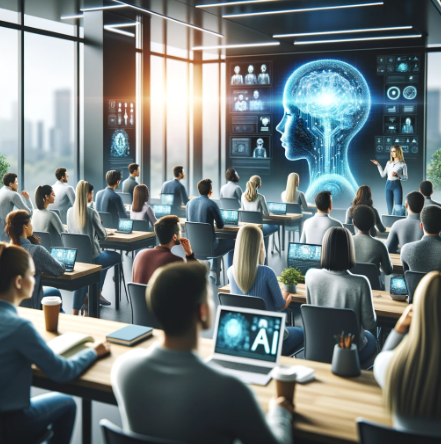Impact of AI on Employment: New Training Challenges

November 19, 2023
Artificial Intelligence (AI) is revolutionizing the world of work, and it is predicted that in the coming years, it could change or eliminate millions of jobs worldwide. This transformation will require extensive retraining of workers to adapt to new opportunities and skills required to avoid falling behind.
How AI is Changing the Work Landscape
Emerging AI technologies, such as ChatGPT, could eliminate or alter the nature of millions of jobs in the next decade. Sectors like marketing and sales, software engineering, research and development, accounting, financial consulting, and writing could be particularly affected. Even workers in sectors that remain may be vulnerable in the future, as AI could change their job duties by automating some, altering others, and creating new ones.
In both cases, there is a clear need to retrain workers affected by the AI revolution. This includes training unemployed workers for jobs less influenced by AI. And acquiring the skills needed to perform one of the millions of new jobs that could be created by these technologies. Additionally, it is essential to help workers develop AI-related skills in their current roles to avoid being left behind.
The Need for Worker Retraining and Massive Retraining
Automation and AI will not directly replace workers. But it will be humans using new technologies that bring about change in the world of work. Therefore, it is crucial to ensure that workers are ready to adapt to new technologies and the new tasks they entail.
According to economist Richard Baldwin, “it’s not AI taking your job; it’s someone using AI to do it.” This statement emphasizes the importance of investing in worker training to ensure they can use the new technologies and required skills.
According to Seth Carpenter, Global Chief Economist at Morgan Stanley, in the long term, the AI revolution could lead to an unprecedented demand for retraining unemployed workers and require a significant increase in training capabilities. Retraining programs and social safety nets, such as unemployment insurance, are more likely to support affected workers compared to policies like a universal basic income, which some have proposed as a solution to AI-caused unemployment.
However, even if training is the solution, implementing this transition is easier said than done. The United States has already faced unemployment challenges in the past and has not always effectively addressed them. For example, the expansion of global trade in the early 2000s led to the loss of millions of manufacturing jobs, causing severe economic hardships in many communities.
Past Experience as a Lesson for the Future
To avoid repeating past mistakes, it is necessary to invest in effective training programs for workers affected by the AI revolution. During the automation of telephone switchboards in the late 19th century, for example, older women suffered the greatest consequences. While younger women were able to adapt and find new employment.
Training must be targeted at specific age groups and the most affected sectors to ensure that no worker is left behind. Younger workers, who are already familiar with technologies like ChatGPT, may have an advantage in adapting to the future of AI. However, additional resources for training older workers may be necessary.
The Role of Companies, Schools, and Governments in Training
Worker training can occur in various ways: through universities and colleges, independent programs, or within companies themselves. However, it is not yet clear who should be responsible for implementing the necessary training.
Some companies have already taken initiatives to ensure their employees keep up with AI. For instance, consulting firm PricewaterhouseCoopers plans to provide AI training to 75,000 workers in the United States and Mexico. The training is designed to teach employees new technologies and how to safely incorporate them into their work.
Schools and EdTech platforms have also started offering AI-focused courses, recognizing the importance of acquiring skills in this field. However, government investments are another crucial element to ensure the success of training. In addition to directing funding towards retraining programs, Congress could adopt fiscal policies that incentivize companies to retrain their workers rather than replace them.








